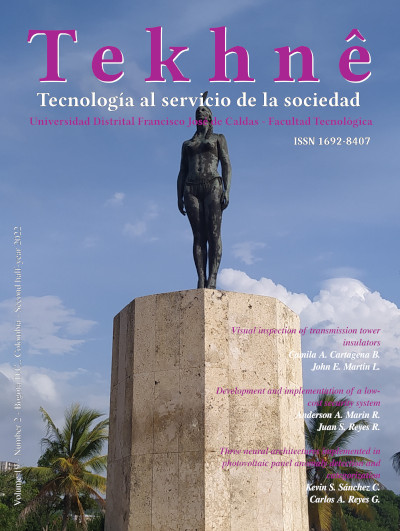Published:
2022-12-30Issue:
Vol. 19 No. 2 (2022): Tekhnê JournalSection:
ArticlesDevelopment and implementation of a low-cost security system
Desarrollo e implementación de un sistema de seguridad de bajo costo
Keywords:
ESP32, HC-SR501, IoT, lector RFID, security system (en).Keywords:
ESP32, HC-SR501, IoT, lector RFID, sistemas de seguridad (es).Downloads
Abstract (en)
One of the main security problems in Colombia is home burglary since most of the time these are left alone during working hours or other types of occupations. This article presents an analysis of the problem of home security due to theft, looking for an effective solution at a lower cost than those available in the market. This arises from the analysis of the figures given by the DANE and a solution is proposed using the ESP32 development board, the HC-SR501 motion sensor, and the RC522 RFID (Radio Frequency Identification) reader, which allows us to generate an economical and reliable security system with the implementation of the IoT (Internet of Things) to make it more versatile.
Abstract (es)
Una de las principales problemáticas de la seguridad en Colombia es el hurto a viviendas, dado que en la mayoría del tiempo estas quedan solas durante los horarios laborales u otros tipos de ocupaciones. En este artículo se presenta un análisis a la problemática de seguridad en las viviendas por hurtos, buscando una solución efectiva y con un costo menor a los que hay en el mercado. Este surge del análisis realizado a las cifras dadas por el DANE y se propone una solución haciendo uso de la placa de desarrollo ESP32, el sensor de movimiento HC-SR501 y el lector RFID (Identificación por radiofrecuencias) RC522lo que nos permite generar un sistema de seguridad económico, fiable y con implementación de las IoT (Internet de las cosas) para que sea más versátil.
References
Escobar, A., Hernández, C., & Martínez, F. Adaptive fuzzy control applied to a speed control (J. S. for Fuzzy Theory & I. Informatics, Eds.). In: 4th soft computing and intelligent systems (scis) and the 9th international symposium on advances intelligent systems (isis) (scis & isis 2008) (J. S. for Fuzzy Theory & I. Informatics, Eds.). Ed. by for Fuzzy Theory, J. S., & Informatics, I. 2008, SA-D3–2.
Martínez, F., Jacinto, E., & Ramírez, D. (2013). Desarrollo e implementación de fotocontrol temporizado con tecnología de bajo consumo. Redes de Ingeniería, 4(2013), 114–121. https://doi.org/10.14483/2248762X.6373
Masykuroh, K., Syifa, F. T., Setiyanto, G. R., Ramadhani, A. D., Kurnianto, D., & Iryani, N. (2021). Prototype smart door lock by using wireless network based on arduino uno. 2021 IEEE International Conference on Communication, Networks and Satellite (COMNETSAT), 342. https://doi.org/10.1109/comnetsat53002.2021.9530806
Medina, C. C. (2020). Metodología general encuesta de convivencia y seguridad ciudadana (ecsc).
Policia Nacional. (2022). Estadística delictiva. https://www.policia.gov.co/grupo-informacion-criminalidad/estadistica-delictiva
Rusyn, V., Sambas, A., & Skiadas, C. H. (2022). Security access using simple RFID reader and arduino UNO: A study case. In Lecture notes in networks and systems (pp. 193–202). Springer International Publishing. https:// doi.org/10.1007/978-3-031-03877-8_17
Saleh, S. B., Mazlan, S. B., Hamzah, N. I. B., Karim, A. Z. Z. B. A., Zainal, M. S. B., Hamzah, S. A. B., Nor, D. B. M., & Poad, H. B. M. (2018). Smart home security access system using field programmable gate arrays. Indonesian Journal of Electrical Engineering and Computer Science, 11(1), 152. https://doi.org/10.11591/ijeecs.v11.i1.pp152-160
Wahyuni, R., Rickyta, A., Rahmalisa, U., & Irawan, Y. (2021). Home security alarm using wemos d1 and HC-SR501 sensor based telegram notification. Journal of Robotics and Control (JRC), 2(3), 200. https://doi.org/10.18196/jrc.2378
How to Cite
APA
ACM
ACS
ABNT
Chicago
Harvard
IEEE
MLA
Turabian
Vancouver
Download Citation
Visitas
Downloads
License
Copyright (c) 2023 Anderson A. Marin R., Juan S. Reyes R.

This work is licensed under a Creative Commons Attribution-NonCommercial-NoDerivatives 4.0 International License.
Those authors who have published with this journal agree to the following terms:
- The authors retain their copyright and guarantee to the journal right of first publication of his work, which will be simultaneously subject to license recognition of Creative Commons that allows others to share the work as long as its author is indicated and its first publication in this journal.
- Authors may adopt other agreements nonexclusive distribution version of the work as long as indicated that the initial publication is in this journal.
- It allows and encourages authors disseminate their work via the Internet before and during the submission process, which can produce interesting exchanges and increase citations of the published work.


